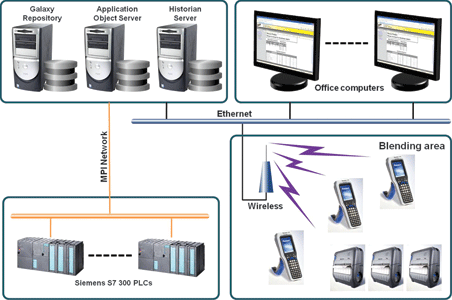

Since its inception in 1984, Imana Foods has expanded in leaps and bounds but to realise its dream of ‘Redeeming Eden’ through caring for its consumers, traders, suppliers and employees, the company needed to gain certification in internationally recognised quality and food safety standards such as ISO 9001 and HACCP (Hazard Analysis, Critical Control Point Methodology). This in turn, required detailed traceability of production processes and materials.
Imana Foods is a member of the Kwaden Investments group and is supported in systems development by a sister company, IT Dynamics, which was tasked with providing a systems solution for product traceability.
Background
Prior to this project, team leaders had no clear visibility into the blending operations. “Blenders worked from instructions printed manually from the ERP system,” says Murray Irvine, project engineer at IT Dynamics. “This meant that the work schedules depended on the reliability of a printer, and the recipe integrity on the reliability of the operator. On the ingredient side, while every effort was made to stick to a first-in-first-out transfer of raw material, this was not always guaranteed and stock discrepancies were identified at the end of every month. There was no real traceability.”
Project goals
For the Imana Foods’ leadership team, faced with an expanding marketplace demanding increased food safety focus, there was a need to review its production operations. This led to the launching of a blender project with the following goals:
1. Full traceability of all materials entering and leaving the savoury powders blending process.
2. Visibility into the blending process.
3. Production data (from Wonderware) to be linked with the company’s ERP system for the automation of real-time work order administration.
* HACCP certification.
* Improve the quality of finished goods.
* Reduce inventory discrepancies.
The scope of the project was to include scada, MES and enterprise integration initiatives that would place Imana Foods in control of its existing production and ready to meet future business and operational challenges.
Solution requirements
To achieve the expressed goals, Imana Foods would rely on a scalable system design where there was to be minimal data duplication between the ERP and production systems. The ERP system would still be responsible for the queuing and prioritising of work orders.
All incoming raw materials needed to be lot managed and scanned into their respective storage locations for tracking into the blenders. This would need to be done for all materials used in the more than 150 recipes in Imana Foods’ range of products. Bags of work in progress from the blenders needed to be individually weighed and tagged with bar-coded labels for tracking through to the packing lines. Full traceability would then be achieved by ink jet coding the finished product.
One of the most important requirements of the system was that it should guide operators on ‘what to do when’, so that printed instructions would no longer be necessary.
“The scada system would verify all transactions and would be the source of daily shift reports,” says Irvine.
Solution selection
“A small InTouch application was already in use monitoring PLCs in the factory,” explains Irvine. “However, that was not the deciding factor for solution selection. For Wonderware, the availability of the PEM (production events module), FMM (formula management module) and the Sequencer objects were core to the solution. The decision was made to go with Wonderware and the purchase of all the other Wonderware solutions necessary to this project (System Platform, ActiveFactory, Historian and Information Server). Paul Alcock, Imana Foods’ MD also believed that Wonderware’s technology was a very good match for the company’s future goals.”
PEM enables users to record production events into a standard database and to know the exact process conditions at a certain step. Users can also report forward and backward genealogy of materials, equipment and production events.
The Sequencer object coordinates tasks that must be executed in a certain sequence or order of operation. It is designed to configure, execute and manipulate a sequence of operations associated with attributes from multiple application objects running within an industrial application. The Sequencer exposes a comprehensive set of attributes that allows users to create SmartSymbols and regular InTouch animations to monitor and control the Sequencer operation. PEM, FMM and Sequencer are now all part of Wonderware’s Equipment Operations Module.
Mobile computers for use by the operators and mobile label printers were both sourced from Intermec due to good service levels, pricing as well as being the only supplier that could support both narrowband and broadband.
On the technology front, Imana Foods chose barcodes over an RFID solution. This decision was based on price and the fact that RFID as a technology is not yet mature enough to give an easy, viable solution. For wireless networking with the mobile computers and printers, broadband was chosen because narrowband could not cope with the InTouch-based operator interface even though graphics and complex displays were eliminated.
Implementation
Because of the scope of the project, many disciplines and skills would be required including a project manager, engineers, business analysts, software developers, network engineers, instrumentation technicians, network administrators and technical support personnel.
Figure 1 shows the system topology. The MPI network was expanded to include the blenders, resulting in 22 PLC nodes being connected to the Wonderware system. The blending area was set up for a wireless infrastructure with handheld PCs and wireless label printers. The handheld PCs are running a managed InTouch application through Microsoft Terminal Services which resides on the Application Object Server. The office computers are connected via the Wonderware Information Server portal to allow viewing of custom and PEM reports.

The system is fully integrated with the company’s ERP system which passes the recipe information to the formula manager which is queried for each ingredient on a bag-by-bag basis in order to load the blender. The PEM objects store acknowledged data from the operators and provide the traceability for lot-tracked raw materials as well as for finished goods. The Sequencer object is used to sequence the blend process. The ERP system is sent the resultant blending process information in order to close the loop and monitor stock levels and any accounting variance anomalies. In addition, custom reports calculate equipment utilisation from time data captured in the Wonderware production database.
“The most important item of information supplied by the system is the raw material lot tracking data as fed into the blenders,” says Irvine. “This is giving Imana Foods a far greater level of control than previously.”
On the handheld units, the blender operators are shown the recipe details as well as an ingredient by ingredient breakdown of what they have to scan or acknowledge as having been fed into the blender. The blender is on load cells which register its weight increase as it is loaded. There are built-in timers that capture the total blend time as well as any additional mixing times that may be required. When being unloaded, platform scales underneath the blenders register the weight of the offloaded bag and this data is captured by the PEM objects.
Benefits
* HACCP certification was achieved within three months of going live.
* Better insight into the blending operation in the factory from a material usage variance point of view.
* Improved raw material stock control.
* Real-time blend closure in the ERP system.
* Factory procedural deviations are highlighted.
* More consistent product quality from following recipes exactly.
* Improved management of the physical blending process.
* Proper temperature control of sensitive blends.
Conclusion
Imana Foods has achieved all its initial project goals and has ambitious plans for expanding and extending the capabilities of the system. This was made possible through the use of a flexible platform in the hands of a very capable project team which amply demonstrated that technology is no longer a barrier to achieving business and operational objectives.
For more information contact Jaco Markwat, Wonderware Southern Africa, 0861 WONDER, [email protected], www.wonderware.co.za

© Technews Publishing (Pty) Ltd | All Rights Reserved